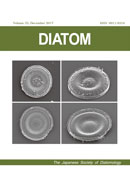33 巻
選択された号の論文の5件中1~5を表示しています
- |<
- <
- 1
- >
- >|
論文
-
2017 年 33 巻 p. 1-11
発行日: 2017/12/20
公開日: 2017/09/27
PDF形式でダウンロード (1146K)
研究ノート
-
2017 年 33 巻 p. 12-13
発行日: 2017/12/25
公開日: 2017/12/28
PDF形式でダウンロード (409K)
論文
-
2017 年 33 巻 p. 21-26
発行日: 2017/12/25
公開日: 2017/12/28
PDF形式でダウンロード (1522K)
短報
-
2017 年 33 巻 p. 14-20
発行日: 2017/12/25
公開日: 2017/12/28
PDF形式でダウンロード (1289K) -
2017 年 33 巻 p. 27-32
発行日: 2017/12/25
公開日: 2017/12/28
PDF形式でダウンロード (1157K)
- |<
- <
- 1
- >
- >|
